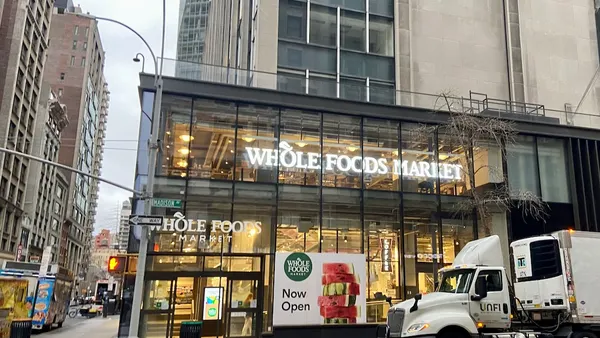Dive Brief:
-
Walgreens Boots Alliance has determined that optimizing its purchase of nearly 2,000 Rite Aid stores will entail the closure of some 600 stores "and related assets" over 18 months, starting next spring, CFO George Rollo Fairweather told analysts on Wednesday, according to a conference call transcript from Seeking Alpha.
-
Most slated for closure will be Rite Aid locations, though some will be Walgreens, Co-Chief Operating Officer Alexander W. Gourlay said, without saying which locations those are. That will cost the retailer about $450 million, mostly in cash, according to Fairweather, but the company will save $300 million or so annually by the end of the fiscal year 2020.
-
The re-brand of Rite Aid stores to the Walgreens banner will cost some $750 million, and Walgreens will invest another $500 million in incremental capital expenditure on store conversions and related activities, Fairweather said.
Dive Insight:
The merger proposed by Walgreens and Rite Aid more than two years ago was subject to long, drawn-out scrutiny by the Federal Trade Commission, which in the end would only agree to the drastically smaller acquisition of stores and distribution centers.
Walgreens Boots CEO Stefano Pessina had remained adamant about making some kind of merger happen, and the companies worked to sweeten the pot for months to move along the process. Speaking to analysts in January, Pessina said the company had "no plan B" if the merger is scuttled. Later that month, at Walgreens' shareholders meeting, he said the organization was "actively engaged in dialogue with the FTC" and declared, "We’ll do anything we can to support their work."
But in June, the company more or less threw in the towel, agreeing instead to buy far fewer Rite Aid stores than Pessina had first envisioned. It was clear that one solution — a spinoff of Rite Aid stores to Fred’s — wouldn't pass muster. In fact, that deal with Fred’s came as a surprise to some analysts because it wasn’t clear how the smaller pharmacy chain would raise the funds. Rival CVS Health, which was set to be dethroned as the nation’s largest drugstore retailer if the merger proceeded, had reportedly warned the FTC that the Safeway deal actually served as a cautionary tale. Without the viability of that deal, there wasn't likely enough competition in the drugstore space to ease the FTC's concerns.
Notably absent in the deal was Fred’s Pharmacy, which had been slated to buy up 865 Rite Aid stores for $950 million — contingent upon the original merger going through. That had reportedly made the scaled down takeover plan announced in June actually more worrisome to some antitrust regulators than the previous, more ambitious plan.
The drawn-out process now has its upside, though. All that time has meant that Rite Aid and Walgreens personnel have been communicating for a while now, making the adjustments necessary to complete and rationalize the takeover easier, executives told analysts on Wednesday. "[F]rom an operational point of view, we feel really good about this execution," Gourlay said, according to Seeking Alpha's transcript. "The team have been working really closely, this has actually gone on for almost two years, and we got going really quickly... We're well prepared and we'll get this job done and execute it really well and get this network inside of Walgreens network."
Most of the Rite Aid stores being closed are quite near Walgreens locations, which also makes the transition smoother, he said. "The vast majority of these closures will be Rite Aid and the vast majority actually being closed are within one mile of another drugstore that we own," he said, noting that Walgreens is about to welcome several talented team members from Rite Aid. "So it really is a micro level and real detail and also we have a very strong record of file transfers."














